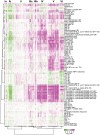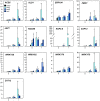Transcriptomics and functional genomics of ROS-induced cell death regulation by RADICAL-INDUCED CELL DEATH1
- PMID: 24550736
- PMCID: PMC3923667
- DOI: 10.1371/journal.pgen.1004112
Transcriptomics and functional genomics of ROS-induced cell death regulation by RADICAL-INDUCED CELL DEATH1
Abstract
Plant responses to changes in environmental conditions are mediated by a network of signaling events leading to downstream responses, including changes in gene expression and activation of cell death programs. Arabidopsis thaliana RADICAL-INDUCED CELL DEATH1 (RCD1) has been proposed to regulate plant stress responses by protein-protein interactions with transcription factors. Furthermore, the rcd1 mutant has defective control of cell death in response to apoplastic reactive oxygen species (ROS). Combining transcriptomic and functional genomics approaches we first used microarray analysis in a time series to study changes in gene expression after apoplastic ROS treatment in rcd1. To identify a core set of cell death regulated genes, RCD1-regulated genes were clustered together with other array experiments from plants undergoing cell death or treated with various pathogens, plant hormones or other chemicals. Subsequently, selected rcd1 double mutants were constructed to further define the genetic requirements for the execution of apoplastic ROS induced cell death. Through the genetic analysis we identified WRKY70 and SGT1b as cell death regulators functioning downstream of RCD1 and show that quantitative rather than qualitative differences in gene expression related to cell death appeared to better explain the outcome. Allocation of plant energy to defenses diverts resources from growth. Recently, a plant response termed stress-induced morphogenic response (SIMR) was proposed to regulate the balance between defense and growth. Using a rcd1 double mutant collection we show that SIMR is mostly independent of the classical plant defense signaling pathways and that the redox balance is involved in development of SIMR.
Conflict of interest statement
The authors have declared that no competing interests exist.
Figures







Similar articles
-
Arabidopsis RCD1 coordinates chloroplast and mitochondrial functions through interaction with ANAC transcription factors.Elife. 2019 Feb 15;8:e43284. doi: 10.7554/eLife.43284. Elife. 2019. PMID: 30767893 Free PMC article.
-
Arabidopsis radical-induced cell death1 is involved in UV-B signaling.Photochem Photobiol Sci. 2009 Jun;8(6):838-46. doi: 10.1039/b901187k. Epub 2009 Apr 9. Photochem Photobiol Sci. 2009. PMID: 19492112
-
Arabidopsis downy mildew effector HaRxL106 suppresses plant immunity by binding to RADICAL-INDUCED CELL DEATH1.New Phytol. 2018 Oct;220(1):232-248. doi: 10.1111/nph.15277. New Phytol. 2018. PMID: 30156022 Free PMC article.
-
Regulation of plant reactive oxygen species (ROS) in stress responses: learning from AtRBOHD.Plant Cell Rep. 2016 May;35(5):995-1007. doi: 10.1007/s00299-016-1950-x. Epub 2016 Feb 16. Plant Cell Rep. 2016. PMID: 26883222 Review.
-
Order by disorder in plant signaling.Trends Plant Sci. 2012 Nov;17(11):625-32. doi: 10.1016/j.tplants.2012.06.010. Epub 2012 Jul 20. Trends Plant Sci. 2012. PMID: 22819467 Review.
Cited by
-
Role of Proteomics in Crop Stress Tolerance.Front Plant Sci. 2016 Sep 8;7:1336. doi: 10.3389/fpls.2016.01336. eCollection 2016. Front Plant Sci. 2016. PMID: 27660631 Free PMC article. Review.
-
Identification of genes governing resistance to PCN (Globodera rostochiensis) through transcriptome analysis in Solanum tuberosum.Funct Integr Genomics. 2023 Jul 15;23(3):242. doi: 10.1007/s10142-023-01164-3. Funct Integr Genomics. 2023. PMID: 37453957
-
Evolutionary conservation of the intrinsic disorder-based Radical-Induced Cell Death1 hub interactome.Sci Rep. 2019 Dec 12;9(1):18927. doi: 10.1038/s41598-019-55385-3. Sci Rep. 2019. PMID: 31831797 Free PMC article.
-
Mycovirus-induced hypovirulence in notorious fungi Sclerotinia: a comprehensive review.Braz J Microbiol. 2023 Sep;54(3):1459-1478. doi: 10.1007/s42770-023-01073-4. Epub 2023 Jul 31. Braz J Microbiol. 2023. PMID: 37523037 Free PMC article. Review.
-
Screening for GmRCD1-Interacting Proteins in Glycine Max and Characterization of the GmRCD1-GmNAC058 Interaction.Int J Mol Sci. 2025 Aug 11;26(16):7760. doi: 10.3390/ijms26167760. Int J Mol Sci. 2025. PMID: 40869078 Free PMC article.
References
-
- Heil M, Hilpert A, Kaiser W, Linsenmair KE (2000) Reduced growth and seed set following chemical induction of pathogen defence: does systemic acquired resistance (SAR) incur allocation costs? J Ecol 88: 645–654.
-
- Jaspers P, Kangasjärvi J (2010) Reactive oxygen species in abiotic stress signaling. Physiol Plant 138: 405–413. - PubMed
Publication types
MeSH terms
Substances
LinkOut - more resources
Full Text Sources
Other Literature Sources
Molecular Biology Databases

